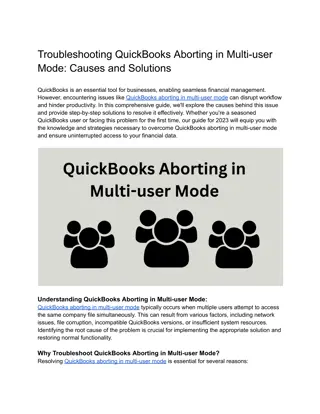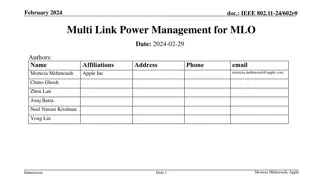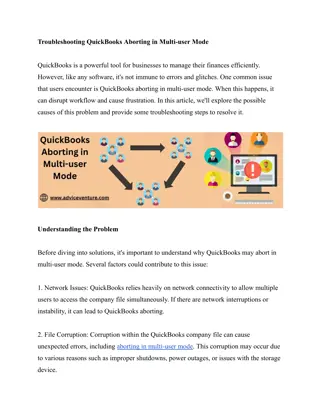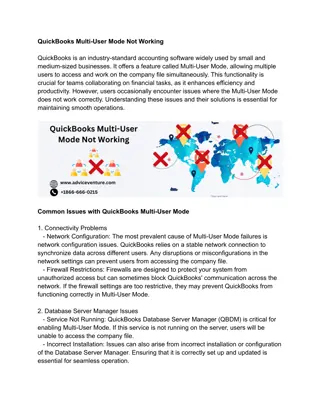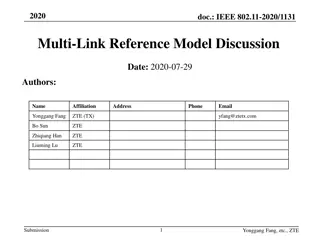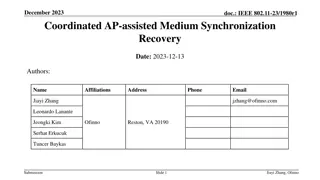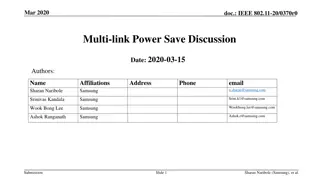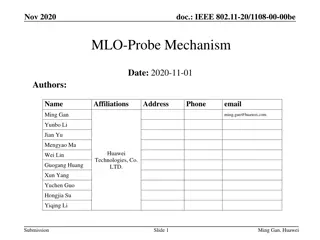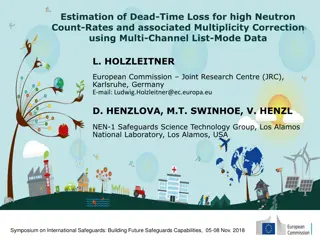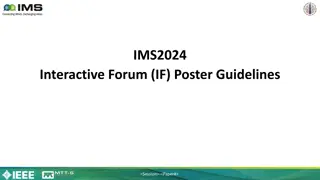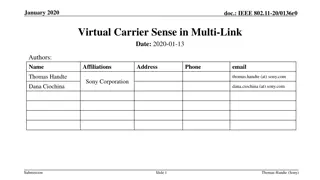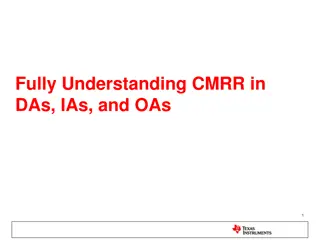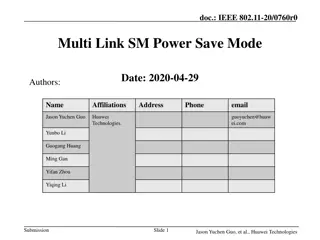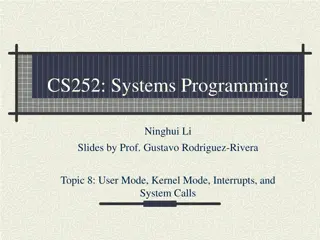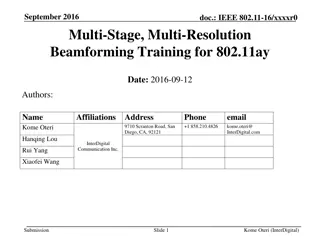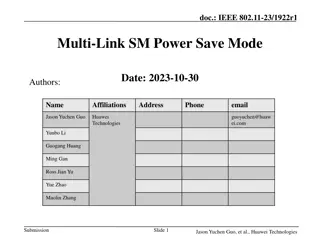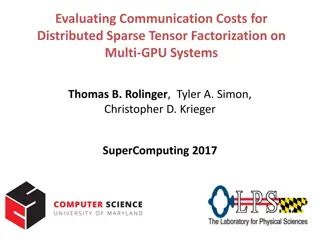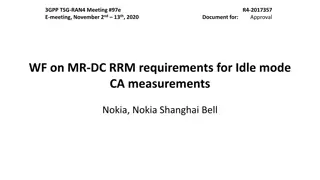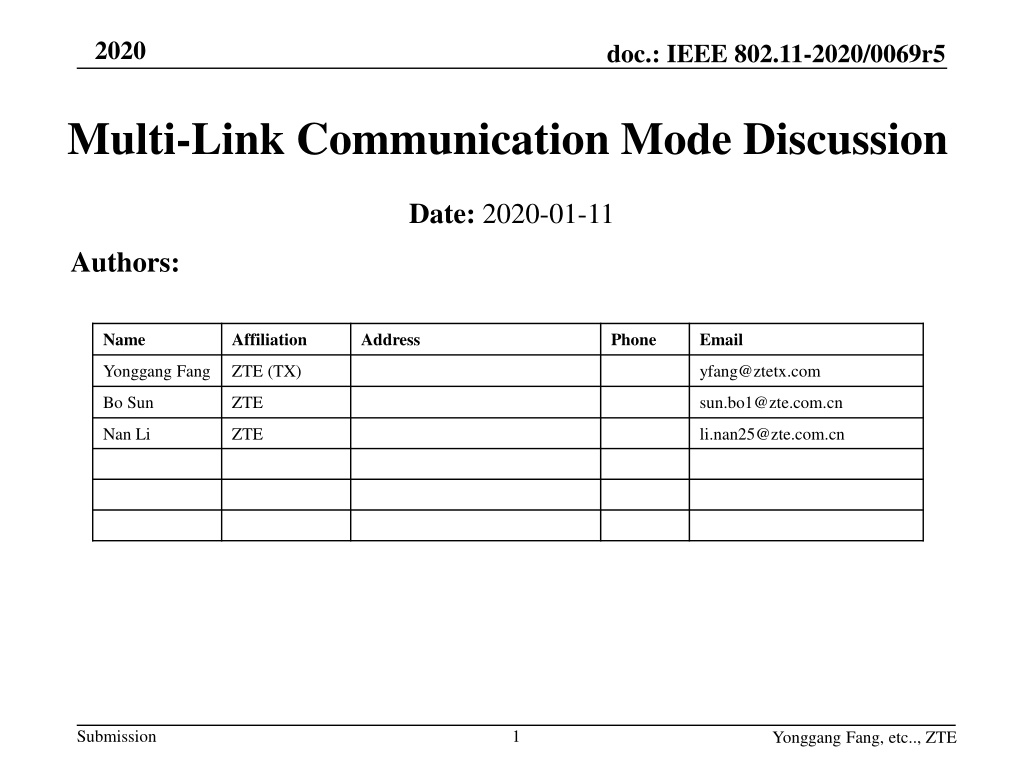
IEEE 802.11-2020 Multi-Link Communication Mode Discussion
"Explore the definition and operation of Multi-Link communication modes in IEEE 802.11-2020 standards. Addressing terms like Simplex, Half Duplex, and Full Duplex, this discussion aims to clarify asynchronous multi-link channel access and terms used in the communication industry."
Download Presentation

Please find below an Image/Link to download the presentation.
The content on the website is provided AS IS for your information and personal use only. It may not be sold, licensed, or shared on other websites without obtaining consent from the author. Download presentation by click this link. If you encounter any issues during the download, it is possible that the publisher has removed the file from their server.
E N D
Presentation Transcript
2020 doc.: IEEE 802.11-2020/0069r5 Multi-Link Communication Mode Discussion Date: 2020-01-11 Authors: Name Affiliation Address Phone Email Yonggang Fang ZTE (TX) yfang@ztetx.com Bo Sun ZTE sun.bo1@zte.com.cn Nan Li ZTE li.nan25@zte.com.cn Submission 1 Yonggang Fang, etc.., ZTE
2020 doc.: IEEE 802.11-2020/0069r5 Abstract This contribution intends to clarify terms used ML operation and proposes the definition of the terms to be used in 802.11be. Submission 2 Yonggang Fang, etc.., ZTE
2020 doc.: IEEE 802.11-2020/0069r5 Background Multi-Link framework requirements ML framework requirements are proposed to support Dynamic selecting and switching an operating link to address the use cases of reducing access latency for fast connection, balancing loads, etc.. Concurrent transmit or receive packets over multiple links to address the use cases of improving transmission reliability and increasing peak-throughput. However, there is no clear definition for concurrent transmit or receive packets over multiple links. Submission 3 Yonggang Fang, etc.., ZTE
2020 doc.: IEEE 802.11-2020/0069r5 Background Terms used in communication industry [1, 2, 3] Simplex communication: a communication channel that operates in one direction at a time, but that may be reversible. Half Duplex communication: a communication channel can operate in both directions, but only one direction at a time (not simultaneously). Full Duplex communication: a duplex communication channel requires two simplex channels operating in opposite directions. Submission 4 Yonggang Fang, etc.., ZTE
2020 doc.: IEEE 802.11-2020/0069r5 Issues on Terms Terms being used in 802.11be In SFD [7], some capability of MLD is described as A MLD that supports multiple links can announce whether it can support transmission on one link concurrent with reception on the other link for each pair of links. 802.11be shall allow the following asynchronous multi-link channel access: Each of STAs belonging to a MLD performs a channel access over their links independently in order to transmit frames. Downlink and uplink frames can be transmitted simultaneously over the multiple links. Term used in some 802.11be contributions Simultaneous transmission and reception (STR) is used in [4, 5] Non simultaneous transmission and reception (non-STR) is used in [4, 5] Synchronous MLD in [6] seems referring to non-STR. And the asynchronous MLD in [6] seems referring to STR. Synchronous and asynchronous transmission mentioned in [5] seems referring to the timing synchronization in transmissions. We suggest to clearly define those terms for multi-link operation in SFD. 5 Submission Yonggang Fang, etc.., ZTE
2020 doc.: IEEE 802.11-2020/0069r5 ML Operation Definition STR: simultaneous transmission and reception STR Operation: is the operation of which a transmission on one link is independent to (i.e. non-interruptible on) the operation on another link. STR-constraint Operation: is the operation of which a transmission on one link will be constrained if causes the reception interruption on another link. Submission 6 Yonggang Fang, etc., ZTE
2020 doc.: IEEE 802.11-2020/0069r5 ML Operation Definition Synchronous Transmission A MLD shall transmit on multiple links frames of which their transmission starting time are aligned within TBD micro-seconds. Asynchronous Transmission A MLD may transmit on multiple links frames of which their transmission starting time may not be aligned within TBD micro-seconds Submission 7 Yonggang Fang, etc., ZTE
2020 doc.: IEEE 802.11-2020/0069r5 Straw Poll (1) Do you support to define the following in SFD ? STR: simultaneous transmission and reception STR Operation: is the operation of which a transmission on one link is independent to (i.e. non-interruptible on) the operation on another link of MLD. STR-constraint Operation: is the operation on a link may depend on the operation of another link of MLD. i.e. a transmission on a link may be constrained if it causes the reception interruption on another link, or a reception on a link may be constrained if a transmission is on anther link of MLD. STR-constraint links: A pair or group of links are in the STR-constraint Operation. YES/NO/ABS Submission 8 Yonggang Fang, etc., ZTE
2020 doc.: IEEE 802.11-2020/0069r5 Straw Poll (2) Do you support to define the following in SFD ? Synchronous Transmission: A MLD transmits on multiple links frames that one or both of the following condition is true: The transmission starting times of the frames are aligned within TBD micro-seconds The transmission ending times of the frames are aligned within TBD micro-seconds Asynchronous Transmission: A MLD transmits on multiple links frames that has no alignment requirement on the transmission starting or ending time of the frames. YES/NO/ABS Submission 9 Yonggang Fang, etc., ZTE
2020 doc.: IEEE 802.11-2020/0069r5 References 1. The IEEE Authoritative Dictionary of Standard Terms, 7th Ed., 2000, Inst. of Electrical and Electronic Engineers, p.1053 2. https://en.wikipedia.org/wiki/Simplex_communication 3. https://en.wikipedia.org/wiki/Duplex_(telecommunications) 4. 11-19-1917-01-00be-considerations-for-multi-link-channel-access-without- simultaneous-tx-rx-capability 5. 11-20-0026-00-00be-mlo-sync-ppdus 6. 11-20-0081-01-00be-mlo-synch-transmission 7. 11-19-1262-07-00be-specification-framework-for-tgbe Submission 10 Yonggang Fang, etc., ZTE
2020 doc.: IEEE 802.11-2020/0069r5 Thank you! Submission 11 Yonggang Fang, etc., ZTE

